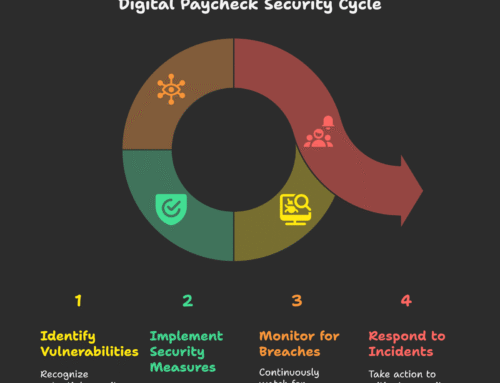Introducing technology into your HR management and payroll is a crucial step towards efficient growth. The benefits are obvious: your specialists have more time on their hands, the team’s growth becomes tangible, and potentially risky areas are a lot more apparent. However, this is possible in the best-case scenarios.
Some companies get lucky with their first choice of an HR system, while for others, it takes trial-and-error to find a working combination. To ensure a successful HR software adoption in your company, it’s best to be aware of possible mistakes and pitfalls. We prepared a checklist and a guide to HR technology adoption – so your team can avoid taking any chances.
Mistake #1 – A rushed choice
Often, teams pick HR software relying on its functionality, interface, and reviews. Evaluating the company’s offers and reputation is essential, but all this information won’t serve you well if you don’t have a final vision. In the end, HR software should be tailored to the needs of your company.
Teams that start adopting HR software without identifying needs, problematic issues, employee’s concerns, and business objectives are a lot more likely to fail.
Mistake #2 – The lack of understanding
When a company’s team lacks an understanding of HR software, its functionality, and basic operations, it’s natural that they prefer to rely on professionals. This approach isn’t wrong, but it’s risky. If you find a trusted software vendor from the get-go, it’s possible to get a valuable insight immediately. In many cases, however, vendors won’t be transparent about all the reasons why their tool is not a fit for your company.
A team needs to have a basic grasp on HR software types, functionality, essential and additional features. Armed with this knowledge, managers will easily tell trustworthy and unreliable vendors apart.
Mistake #3 – Miscommunications with employees
Under no circumstances, managers should consider implementing HR software without getting to know an employee’s opinions. It’s likely that they won’t need some features, or that managers overlooked the important ones. This is especially important for companies that work with many departments. There’s no way one person can be aware of the specifics of every field, and be able to evaluate HR software objectively.
Mistake #4 – Not paying enough attention to security
HR software handles a lot of personal and financial data. Many teams take safety practices for granted, thinking that most vendors are careful about following standards. However, not all tools on the market share the same level of encryption quality, storage protection, data immutability. You need to find out how and where the information will be stored if it is deleted, who has the access rights, and how to navigate security issues if they appear. If a vendor has no answers to one of three crucial questions, your data could end up jeopardized.
Mistake #5 – Disregarding customer services
The functionality and interface of the HR platform are considered the primary choice factors. Caught up in analyzing features and design, few teams give enough thought to a support team. When you are implementing an HR system, transferring data, teaching your employees, and switching operations, you will need guidance. According to a research of HRIS consulting, their clients consider the following software evaluation criteria:
This includes unlimited access to all education materials, direct contact with the support team, variety of communication channels (email, phone, social media). A vendor should tell you how and when they are ready to answer your requests and have a hotline in case an urgent crisis happens.
HR software: How to avoid selection mistakes
You have already known what potential issues to watch out for, but obviously, it’s even better to know how to face the situation proactively. Here are six simple steps that you can do to ensure a successful HR technology adoption.
Determine the needs of your company
- Analyze your weekly, monthly, quarterly, and yearly reports to get a numeric representation of your team’s productivity, results, and performance. There are tools that measure these metrics automatically – so you don’t have to go through piles of documentation.
- Talk to employees. Conducting anonymous surveys and one-on-one interviews are common ways of gathering information directly from your team.
- Take a look at competitors. Often, you might not be aware that your team is missing out on some innovations or has a bottleneck. Analyzing the way other companies handle the same processes could help you uncover hidden problems.
Consider enough vendors
- Make a shortlist of 10-15 vendors, and contact all of them proactively. At this stage, it’s tempting to narrow the choice circle down, but the best way to test a provider is via personal communication.
- Consult experts. The strategy of analyzing multiple offers has one disadvantage: it’s easy to get overwhelmed when considering many tools simultaneously. This is why we recommend reaching out to software developers who’ve built similar tools and had direct insights.
- Consider reviews and social media. Although not all of them might be genuine, user comments are still your best bet when it comes to making an informed choice.
Make sure HR software communicates with other programs used in the company
- HR platforms do not function standalone. There are too many additional areas involved in recruiting, team management, onboarding, and monitoring. Having integrations with ready and custom CRMs, ERPs, ATSs and management tools is essential.
- Add-ons are a must. The platform shouldn’t limit you only to the built-in functionality. If the service offers you no opportunities to expand beyond core features, it’s a poorly scalable solution.
- Try out demo-versions. Trial editions of the software should also feature basic integrations. When you are trying an HR software, you have to know how it functions with your CRM before making a final payment.
Assign responsible managers
- HR implementation should be your high-priority task. It’s not a routine management or maintenance procedure, but an innovation that will affect your company’s productivity for years. Make sure that your team understands this message.
- You need innovation advocates – people who will push the adoption of the tool, educate employees and solve technical issues. Ideally, these should be HR specialists and developers since they are involved in recruiting and technology.
- Encourage team members to support HR software. Show them the benefits of using a tool and don’t overburden them with documentation and monitoring. Although for many HR tools, improved control is indeed a key benefit, your employees shouldn’t see a platform as just a means of oversight.
Make an implementation map before going live
- Use mind maps and diagrams to visualize the preparation and implementation of HR software. Your team can participate in the process of creating and editing a mind map. Before the release, such visual guides should be available to each team member – so they are not overwhelmed.
- Create a step-by-step plan. Your HR technology implementation strategy should not be chaotic. Create a precise algorithm that your company will follow.
- Discuss typical processes with vendors. Providers have a lot more experience in implementing HR software – it’s their job to handle those shifts. Reach out to your provider for an expert opinion.
Never stop training your team
- The process of getting used to an HR tool doesn’t end even in a year after implementations. Surprises might appear due to new releases, hardware or software changes, updates of integrations. There are many factors that could suddenly complicate user experience, and it’s your job to be always aware of them.
- Lead by example. Be enthusiastic about exploring new features of the software, updating security patches, and reaching out to vendors. Employees should see that their managers are passionate about embracing innovation.
Bottom line
Teams are happy to embrace innovations that make their work and life more comfortable. That’s why successful technology adoption starts with communication. Keeping in touch with your vendor, consulting employees, and having an expert opinion – these are the milestones of HR innovations.
On top of that, managers should remember that HR software is not adopted in one go. It’s an ongoing process that will inevitably take months. Even after your team is ultimately used to the new software, you should never stop getting their feedback and looking for ways to boost productivity further. It’s an ongoing process, just like a team’s growth itself.







Your expertise in digital marketing strategy is truly commendable. Thanks for sharing your insights!
Your blog has become my daily dose of positivity and inspiration It’s a space that I always look forward to visiting
Your words have a way of resonating deeply with your readers Thank you for always being encouraging and uplifting
Wow, this blogger is seriously impressive!
Keep up the amazing work!
I love how your posts are both informative and entertaining You have a talent for making even the most mundane topics interesting
Your blog has been a constant source of support and encouragement for me I am grateful for your words of wisdom and positivity
I appreciate the effort that goes into creating high-quality content, and this post was no exception. The insights and information were top-notch and made for a really engaging read. Keep up the great work!
I want to express my appreciation for the writer of this blog post. It’s clear they put a lot of effort and thought into their work, and it shows. From the informative content to the engaging writing style, I thoroughly enjoyed reading it.
Your blog has become my go-to source for inspiration and motivation I am so grateful for the valuable content you provide
This blog post is packed with great content!
I have recommended this blog to all of my friends and family It’s rare to find such quality content these days!
Your writing is so eloquent and engaging You have a gift for connecting with your readers and making us feel understood
Your way of thinking is really inspiring.
Hi there to all, for the reason that I am genuinely keen of reading this website’s post to be updated on a regular basis. It carries pleasant stuff.
Pretty! This has been a really wonderful post. Many thanks for providing these details.
I have been browsing online more than three hours today yet I never found any interesting article like yours It is pretty worth enough for me In my view if all website owners and bloggers made good content as you did the internet will be a lot more useful than ever before
Nice post. I learn something totally new and challenging on websites
Keep up the fantastic work and continue to inspire us all!
The photographs and visuals used in this blog are always stunning They really add a beautiful touch to the posts
I love how this blog promotes a healthy and balanced lifestyle It’s a great reminder to take care of our bodies and minds
From start to finish, your content is simply amazing. You have a talent for making complex topics easy to understand and I always come away with valuable insights.
Keep up the fantastic work!
From start to finish, your content is simply amazing. You have a talent for making complex topics easy to understand and I always come away with valuable insights.
Your blog is always a highlight of my day
Keep up the incredible work! I can’t wait to see what you write next.
You’re so awesome! I don’t believe I have read a single thing like that before. So great to find someone with some original thoughts on this topic. Really.. thank you for starting this up. This website is something that is needed on the internet, someone with a little originality!
From the insightful commentary to the captivating writing, every word of this post is top-notch. Kudos to the author for producing such fantastic content.
Good post! We will be linking to this particularly great post on our site. Keep up the great writing
I like the efforts you have put in this, regards for all the great content.
It means the world to us to hear such positive feedback on our blog posts. We strive to create valuable content for our readers and it’s always encouraging to hear that it’s making an impact.
I very delighted to find this internet site on bing, just what I was searching for as well saved to fav
I’ve come across many blogs, but this one truly stands out in terms of quality and authenticity Keep up the amazing work!
This was beautiful Admin. Thank you for your reflections.
I like the efforts you have put in this, regards for all the great content.
Thank you for the awesome content, it’s always appreciated
Keep up the fantastic work and continue to inspire us all!